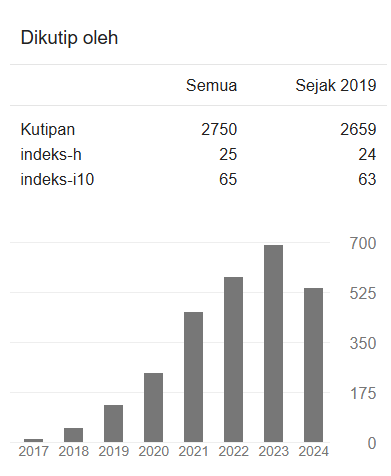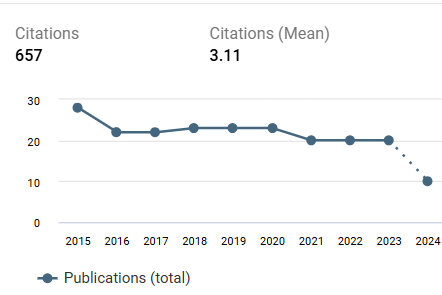Gender differences learning strategy at English Language Education Department Students University Of Muhammadiyah Malang
DOI:
https://doi.org/10.22219/jinop.v7i2.10476Keywords:
Gender Studies, Gender Differences, Learning StrategiesAbstract
Gender difference can be assumed as an individual difference generally existing and catching attention in the foreign language teaching and learning.This research aims at finding out the strategies used by the students in learning English and students’ perspective on the learning strategies based on their gender. The data are gathered through questionnaires and interview which are given to the students of English Language Education Department. This study discovered that male and female students differ in the learning strategy, and the female students score higher in the use of learning strategy than the males. Metacognitive and social learning strategy were highly used by female students. On the other hand, male students score compensation, metacognitive and cognitive learning strategy as their attempts to learn English. The result also found that females use all the strategies more often than males particularly on metacognitive strategy. Moreover, there are differences in the use of other strategies, but the finding is not remarkable.
Downloads
References
Adityo, A. (2020). Dynamics System Analysis in Measuring English Language Performance. ELITE, 2(1), 1–8. Retrieved from http://www.elitejournal.org/index.php/ELITE/article/view/30
Alhaysony, M. (2017). Language Learning Strategies Use by Saudi EFL Students: The Effect of Duration of English Language Study and Gender. Theory and Practice in Language Studies, 7(1), 18. https://doi.org/10.17507/tpls.0701.03
Biabani, M., & Izadpanah, S. (2019). The study of relationship between Kolb’s learning styles, gender and learning American slang by Iranian EFL students. International Journal of Instruction, 12(2), 517–538. https://doi.org/10.29333/iji.2019.12233a
Bloemen-Bekx, M., Voordeckers, W., Remery, C., & Schippers, J. (2019). Following in parental footsteps? The influence of gender and learning experiences on entrepreneurial intentions. International Small Business Journal: Researching Entrepreneurship, 37(6), 642–663. https://doi.org/10.1177/0266242619838936
Chafe, W. (2010). Literature as a window to the mind. Acta Linguistica Hafniensia, 42(Supplement 1), 51–63. https://doi.org/10.1080/03740463.2010.482315
Crippen, K. J., & Antonenko, P. D. (2018). Designing for Collaborative Problem Solving in STEM Cyberlearning. https://doi.org/10.1007/978-3-319-66659-4_5
Danko, M., & Dečman, M. (2019). The strategy inventory for second language learning: Tested, adapted, and validated in the slovenian higher education context. ESP Today, 7(2), 207–230. https://doi.org/10.18485/esptoday.2019.7.2.5
Ender, A. (2014). Implicit and explicit cognitive processes in incidental vocabulary acquisition. Applied Linguistics, 1–26. https://doi.org/10.1093/applin/amu051
García Mayo, M. del P., & Lázaro Ibarrola, A. (2015). Do children negotiate for meaning in task-based interaction? Evidence from CLIL and EFL settings. System, 54, 40–54. https://doi.org/10.1016/j.system.2014.12.001
Ghaith, G., & El-Sanyoura, H. (2019). Reading comprehension: The mediating role of metacognitive strategies. Reading in a Foreign Language, 31(1), 19–43.
Gowthami, S., & Venkatakrishnakumar, S. (2016). Impact of Smartphone : A pilot study on positive and negative effects. International Journal of Scientific Engineering and Applied Science, 3(2), 2395–3470. Retrieved from www.ijseas.com
Gustafsson Sendén, M., Bäck, E. A., & Lindqvist, A. (2015). Introducing a gender-neutral pronoun in a natural gender language: the influence of time on attitudes and behavior. Frontiers in Psychology, 6(July), 1–12. https://doi.org/10.3389/fpsyg.2015.00893
Hedges, S., Borgerhoff Mulder, M., James, S., & Lawson, D. W. (2016). Sending children to school: Rural livelihoods and parental investment in education in northern Tanzania. Evolution and Human Behavior, 37(2), 142–151. https://doi.org/10.1016/j.evolhumbehav.2015.10.001
Hirschberg, J., & Manning, C. D. (2015). Advances in natural language processing. Science. https://doi.org/10.1126/science.aaa8685
Inayati, N. (2015). English Language Teachers’ Use of Social Media Technology in Indonesian Higher Education Context. Asian EFL Journal, 17(4), 6–35.
Jeong, D. C., Feng, D., Krämer, N. C., Miller, L. C., & Marsella, S. (2017). Negative feedback in your face: Examining the effects of proxemics and gender on learning. Lecture Notes in Computer Science (Including Subseries Lecture Notes in Artificial Intelligence and Lecture Notes in Bioinformatics), 10498 LNAI, 170–183. https://doi.org/10.1007/978-3-319-67401-8_19
Kacetl, J., & Klímová, B. (2019). Use of smartphone applications in english language learning—A challenge for foreign language education. Education Sciences, 9(3), 1–9. https://doi.org/10.3390/educsci9030179
Kashiwagi, K., & Tomecsek, J. (2015). How CLIL Classes Exert a Positive Influence on Teaching Style in Student Centered Language Learning Through Overseas Teacher Training in Sweden and Finland. Procedia - Social and Behavioral Sciences, 173, 79–84. https://doi.org/10.1016/j.sbspro.2015.02.034
Leavy, S. (2018). Gender bias in artificial intelligence: The need for diversity and gender theory in machine learning. Proceedings - International Conference on Software Engineering, (October), 14–16. https://doi.org/10.1145/3195570.3195580
Leis, A., Tohei, A., & Cooke, S. D. (2015). Smartphone Assisted Language Learning and Autonomy. International Journal of Computer-Assisted Language Learning and Teaching, 5(3), 75–88. https://doi.org/10.4018/ijcallt.2015070105
Livingston, L. A., Shah, P., & Happé, F. (2019). Compensatory strategies below the behavioural surface in autism: a qualitative study. The Lancet Psychiatry, 6(9), 766–777. https://doi.org/10.1016/S2215-0366(19)30224-X
Macintyre, P. D., & Legatto, J. J. (2011). A dynamic system approach to willingness to communicate: Developing an idiodynamic method to capture rapidly changing affect. Applied Linguistics, 32(2), 149–171. https://doi.org/10.1093/applin/amq037
Manzoor, S., Sarwar, S., & Asim, M. (2020). M-Learning in Higher Education: Exploring the Gender Based Faculty Performance of Business Schools in Pakistan. Pakistan Journal of Gender Studies, 20(1), 195–210. https://doi.org/10.46568/pjgs.v20i1.428
Mulder, K., & Hulstijn, J. H. (2011). Linguistic skills of adult native speakers, as a function of age and level of education. Applied Linguistics, 32(5), 475–494. https://doi.org/10.1093/applin/amr016
Mutlu, A. K., Solhi Andarab, M., & Karacan, C. G. (2019). Self-efficacy and the use of compensatory strategies: A study on EFL learners. European Journal of Educational Research, 8(1), 249–255. https://doi.org/10.12973/eu-jer.8.1.249
Saputro, Teguh Hadi; Adityo, Adityo; Wardhany, A. A. (2017). INTEGRATING STRATEGY-BASED INSTRUCTIONS IN 7 th -GRADE SPEAKING CLASSROOM AT SMP MUHAMMADIYAH 2 BATU. Jurnal Inovasi Pembelajaran, 3, 550–560.
Sauro, S. (2012). L2 performance in text-chat and spoken discourse. System. https://doi.org/10.1016/j.system.2012.08.001
Şen, H. Ş. (2013). The Attitudes of University Students Towards Learning. Procedia - Social and Behavioral Sciences, 83, 947–953. https://doi.org/10.1016/j.sbspro.2013.06.177
Snell, J. (2010). From sociolinguistic variation to socially strategic stylisation. Journal of Sociolinguistics, 14(5), 630–656. https://doi.org/10.1111/j.1467-9841.2010.00457.x
Tsukamoto, M. (2012). Students’ perception of teachers’ language use in an EFL classroom. 大阪女学院大学紀要, 8, 143–154.
Downloads
Published
How to Cite
Issue
Section
License
Copyright (c) 2021 Andini et al

This work is licensed under a Creative Commons Attribution 4.0 International License.
Copyright Notice
Authors who publish with JINoP (Jurnal Inoasi Pembelajaran) agree to the following terms:
- For all articles published in the JINoP (Jurnal Inovasi Pembelajaran), copyright is retained by the authors. Authors give permission to the publisher to announce the work with conditions. When the manuscript is accepted for publication, the authors agree to the automatic transfer of the publishing right to the publisher.
- Authors retain copyright and grant the journal the right of first publication with the work simultaneously licensed under a Creative Commons Attribution 4.0 International License. that allows others to share the work with an acknowledgment of the work's authorship and initial publication in this journal.
- Authors are able to enter into separate, additional contractual arrangements for the non-exclusive distribution of the journal's published version of the work (e.g., post it to an institutional repository or publish it in a book), with an acknowledgment of its initial publication in this journal.
- Authors are permitted and encouraged to post their work online (e.g., in institutional repositories or on their website) prior to and during the submission process, as it can lead to productive exchanges, as well as earlier and greater citation of published work (See The Effect of Open Access).








